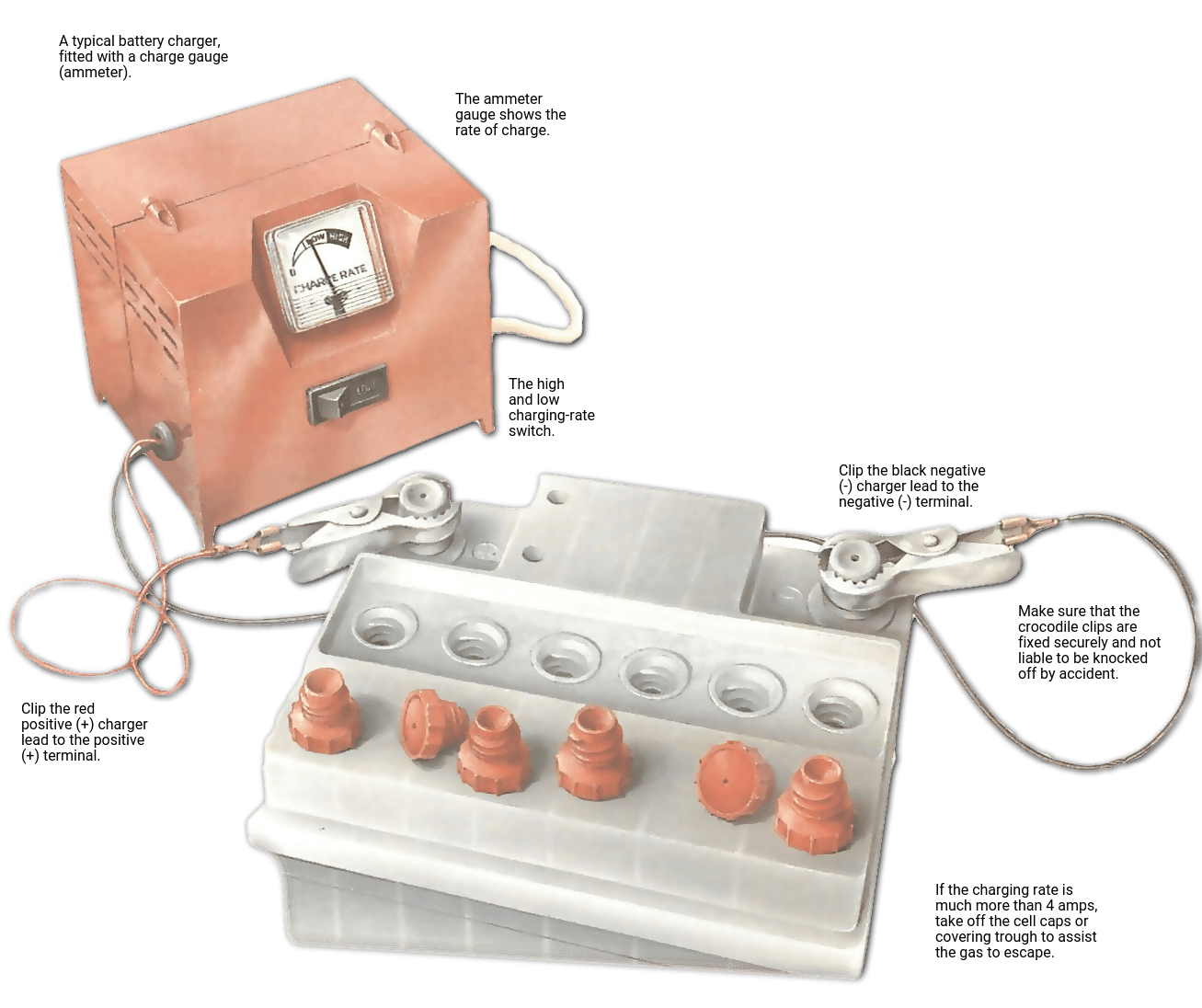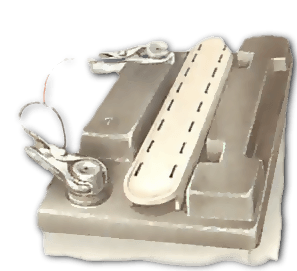Using a car battery charger
The Video Course teaches you everything about modern cars.
Frequent short trips, with constant stopping and starting, make your battery work very hard, especially in winter when heater, headlights , heated windows and wipers may be working most of the time.
Eventually, because more current is being drained from the battery than the alternator can put back, the battery will not have enough power left to turn the starter motor . A battery in that state of discharge is said to be flat .
A flat battery can be avoided if you have a battery charger - a relatively cheap, but worthwhile accessory.
It uses mains current to replace the battery's lost charge through positive and negative leads that clip to the corresponding battery posts .

An average car battery has a capacity of around 48 amp hours which means that, fully charged, it delivers 1 amp for 48 hours, 2 amps for 24 hours, 8 amps for 6 hours and so on.
A basic charger usually charges at around 2 amps - and so needs 24 hours to deliver the 48 amps needed to fully charge a flat, 48 amp hour battery.
But there is a wide range of chargers with different charge rates on the market - from 2 to 10 amps. The higher the charge output, the faster a flat battery is recharged. Fast charging, however, is undesirable as it can buckle the battery plates .
The loads imposed on your battery may be gauged from the amount of current used by the various electrical components: headlights take about 8 to 10 amps, a heated rear window about the same.
Theoretically, a fully charged battery, without taking in current from the generator , should work the starter for about ten minutes, or the headlights for eight hours, and a heated rear window for 12 hours. As the battery nears full discharge, the lights gradually grow dimmer and finally go out altogether.
There are also causes other than short trips and cold weather which can affect the state of your battery. Failure is more common on cars equipped with a dynamo rather than an alternator , because the alternator produces more electricity and charges better at low engine speeds (See How the charging system works ).
The answer in all these cases is frequent testing with a hydrometer (See Checking the batteries ) to see how much capacity is left in the battery, and using a battery charger to top up its charge when necessary.
Connecting a battery charger

Always check the electrolyte level before connecting the battery to the charger. Top up if necessary (See Checking the batteries ) and clean the battery posts.
If there is a power point handy, the battery can be left in the car, so long as the charge rate is only 3 or 4 amps.
However, if the car has an alternator, disconnect the battery terminals beforehand: otherwise some alternators - generally the older type - can be damaged.
If separate cell caps are fitted, remove them for ventilation. Leave a trough cover on, unless the charging rate is high. Clamp the positive (+) lead from the charger, usually coloured red, to the positive battery post. Clamp the negative (-) lead, usually black, to the negative terminal .
Plug the charger into the mains and switch on. The indicator light or gauge ( ammeter ) will show that the battery is being charged.
The gauge may show a high charging rate at first, but this drops gradually as the battery becomes charged.
If it was very flat, charging is likely to take a long time; check periodically with a hydrometer, while continuing the charge.
In the final stages, the cells bubble and give off gas . If any of them begin gassing before others, or do so more violently, the battery is probably defective and should be checked by a garage or battery specialist.
Unplug before disconnecting
After charging, always switch off at the mains and unplug the charger before removing its terminal clips - otherwise the clips may spark as you take them off and ignite gas given off during charging.
Make sure also that no electrical circuits are switched on in the car when you reconnect the battery - a spark may occur as you replace the second battery terminal and ignite battery gas.
Types of car battery charger
A basic home battery charger incorporates a transformer and rectifier, to change the mains 110/220 volt alternating current to 12 volt direct current , and allows the mains supply to provide a charging current at a rate determined by the state of the battery.
In the case of a battery in good condition, the rate of charge may be around 3 to 6 amps with a normal home charger.
A battery at the end of its useful life may not accept any recharging, and will not, in any case, hold a charge.
Some chargers are fitted with a high and low (Hi-Lo) switch to give a choice of two charging rates - typically 3 or 6 amps - in case you want to give the battery a short overnight boost at 6 amps rather than a longer charge at 3 amps.
Many have a charge indicator which may be a warning light, or a gauge showing the charge rate in amps.
Note that the mains lead on all chargers should be fuse d. If it is not, use a three-pin fused plug. As an extra precaution, fit a line fuse cable lead to the battery.
The Ultimate Car Mechanics video course
Learn everything about modern cars from our new video series.
Learn more >-
We build a Mazda MX5 Miata from scratch
We start by tearing down and then rebuilding the whole car.
-
Every part explained
There's ridiculous detail on every part. Clearly and easily explained.
-
All modeled in 3D
We've created the most detailed 3D model ever produced so we can show you everything working.






